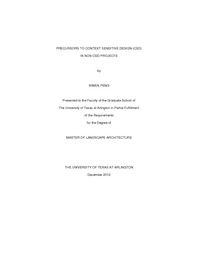| dc.description.abstract | This study searches for planning and design strategies required in Context Sensitive Design (CSD) transportation projects executed prior to the establishment of CSD standards. CSD is &ldquo a collaborative, interdisciplinary approach in which all stakeholders develop transportation facilities that fit their physical settings and preserve the aesthetic, scenic, historic and environmental resources, while maintaining safety and mobility&rdquo (Center for Transportation and Environment (CTE), 2007).There were five pilot states which were Connecticut, Kentucky, Maryland, Minnesota, and Utah, agreed to implement the CSD approach in 1998. In the following years, many states looked to CSD as a more effective approach for improving long-term mobility. In the meantime, researchers of CSD, in the past, focused on identifying and retrieving CSD principles from completed transportation projects (NCHRP Report 642, 2009). However, there were little evidence of a systematical and comprehensively exploration of CSD in the completed transportation projects with regards to the investigate planning and design strategies for current and future projects.This research used two non- CSD, but completed context-themed projects as research targets. Both were completed projects in North Texas and executed prior to the establishment of CSD standards were implemented officially in 1998. One is the IH 30 Three Bridge Corridor Enhancement project along the Arlington (Texas) Entertainment District, and the other is the US 75 North Central Expressway Transportation Project in Dallas, Texas. Both project adopted planning and design strategies which were very similar in many respects to what is now called CSD. In addition, both were started prior to the implementation of CSD, and involved interdisciplinary teams consisting of state agencies, local governments, and private entities. The study sites included in their programming the increasing population of the Dallas-Fort Worth (DFW) metropolitan area, traffic mobility, and improvement of the regional economy. Both projects also respected local cultural, historical, and environmental features. For these reasons, it can be said that study sites comprehensively represented the integration of &ldquo CSD&rdquo into transportation planning and design decision-making.This research seeks to benefit future transportation projects by determining how diffused the knowledge of CSD is in planning and design prior to implement of CSD. This research uses qualitative research methods by interviewing with stakeholders and professionals who involved in study sites to determine their experience related to diffused knowledge of CSD strategies. The interview questions also includes how different the projects would be if the strategies of CSD had been applied. By analyzing qualitative data from interviews, this research expands understanding of how CSD standards emerged from practices in place prior to establishment of Context Sensitive Design. | en_US |


